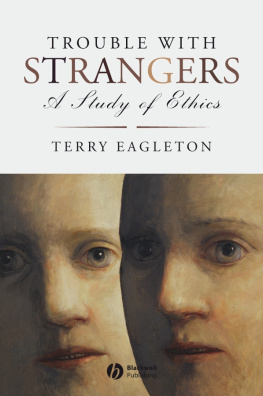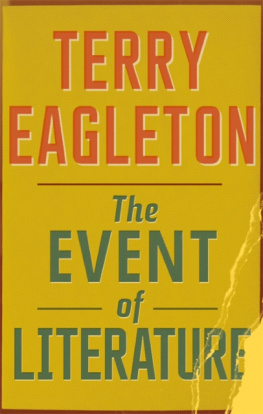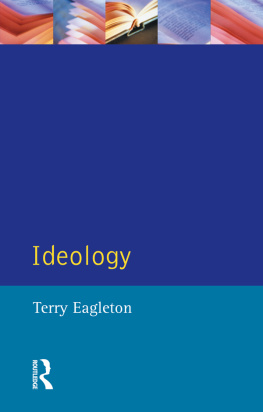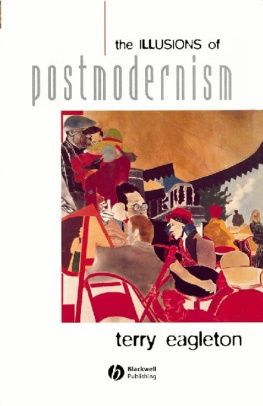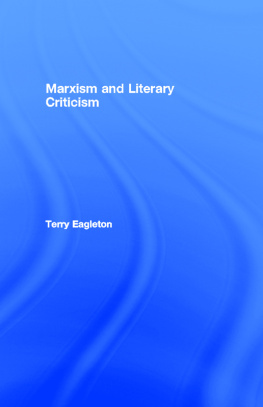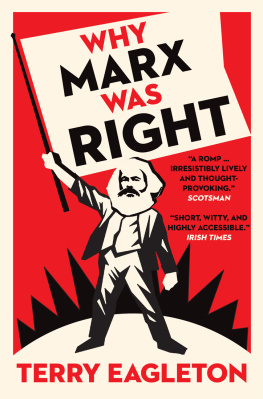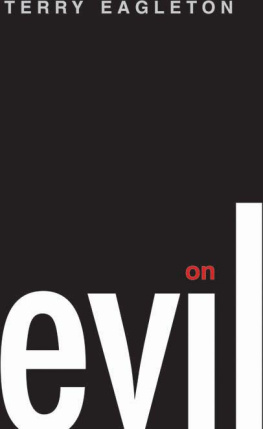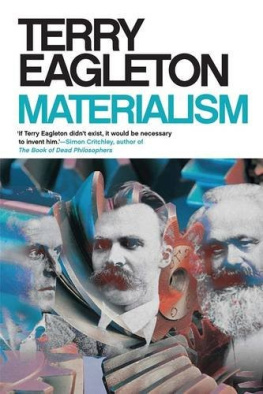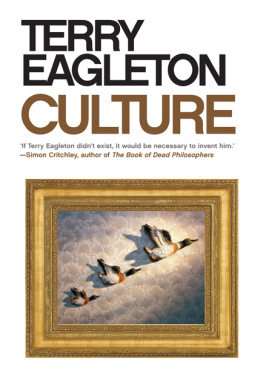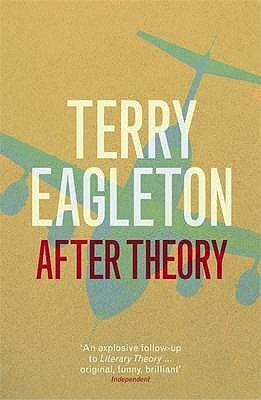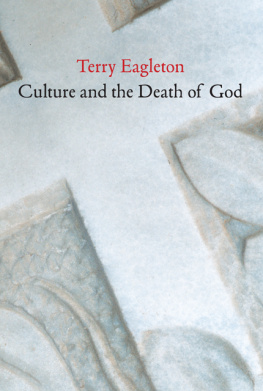In memory of Charles Swann
Endless kindness, endless courage

This edition first published 2009
2009 Terry Eagleton
Blackwell Publishing was acquired by John Wiley & Sons in February 2007. Blackwells publishing program has been merged with Wileys global Scientific, Technical, and Medical business to form Wiley-Blackwell.
Registered Office
John Wiley & Sons Ltd, The Atrium, Southern Gate, Chichester, West Sussex, PO19 8SQ, United Kingdom
Editorial Offices
350 Main Street, Malden, MA 02148-5020, USA
9600 Garsington Road, Oxford, OX4 2DQ, UK
The Atrium, Southern Gate, Chichester, West Sussex, PO19 8SQ, UK
For details of our global editorial offices, for customer services, and for information about how to apply for permission to reuse the copyright material in this book please see our website at www.wiley.com/wiley-blackwell.
The right of Terry Eagleton to be identified as the author of this work has been asserted in accordance with the Copyright, Designs and Patents Act 1988.
All rights reserved. No part of this publication may be reproduced, stored in a retrieval system, or transmitted, in any form or by any means, electronic, mechanical, photocopying, recording or otherwise, except as permitted by the UK Copyright, Designs and Patents Act 1988, without the prior permission of the publisher.
Wiley also publishes its books in a variety of electronic formats. Some content that appears in print may not be available in electronic books.
Designations used by companies to distinguish their products are often claimed as trademarks.
All brand names and product names used in this book are trade names, service marks, trademarks or registered trademarks of their respective owners. The publisher is not associated with any product or vendor mentioned in this book. This publication is designed to provide accurate and authoritative information in regard to the subject matter covered. It is sold on the understanding that the publisher is not engaged in rendering professional services. If professional advice or other expert assistance is required, the services of a competent professional should be sought.
Library of Congress Cataloging-in-Publication Data
Eagleton, Terry, 1943
Trouble with strangers : a study of ethics / Terry Eagleton.
p. cm.
Includes bibliographical references and index.
ISBN 978-1-4051-8572-1 (pbk. : alk. paper)ISBN 978-1-4051-8573-8 (hardcover : alk. paper) 1. Ethics. I. Title.
BJ1012.E23 2008
170dc22
2008011376
PART I
THE INSISTENCE OF THE IMAGINARY
Introduction: The Mirror Stage
No piece of leftist cultural criticism of the 1970s and 1980s seemed complete without an account of Jacques Lacans theory of the mirror stage that moment in the development of a small child when, contemplating its own reflection in a mirror, it delights in the magical correspondence between its own movements and those of the image before its eyes. Magical correspondences and miraculous affinities are the stuff of myth; and if Lacans essay The Mirror Stage investigated such a myth, it rapidly became one in its own right. The boundaries between reality and make-believe, so Lacan argues, are blurred in this early phase: the ego, our window on the so-called real world, is really a kind of fiction, while the child before the mirror is said to treat its image as real even though it knows it to be illusory. A similar ambiguity applies to the word imaginary, which for Lacan means pertaining to an image rather than fantastic or unreal, yet which (like the theory of ideology which Louis Althusser was famously to derive from it) involves delusion and deception even so.
In a mirroring kind of way, the fictional or real-life status of Lacans argument itself came into question. Was the mirror stage meant to be literal or metaphorical? Was this most mandarin of French intellectuals really talking about something as embarrassingly empirical as toddlers? How on earth could one actually know what a child might experience in this situation? What to raise the kind of commonsensical objection of which only the English are capable about societies which did not enjoy the privilege of possessing mirrors? Would ponds or rivers do just as well? Or is the true mirror of the child its parent or carer, who by investing different parts of its body (face, orifices, etc.) with variable degrees of intensity, builds up for the infant a somatic self-portrait? Are our bodies, like our desire, constituted by the Other? How odd, in any case, that such a momentous piece of theorising should be based on that most fictive and primitive of all human activities, play and play-acting! Playacting, to be sure, as well as play for the child jubilantly imitating its own motions in the mirror is a mimic, a miniscule magician who can alter reality simply by raising his hand, an actor performing before an appreciative audience of one, a pocket-sized artist who revels in his ability to shape and transform his product at the flick of a finger or the turn of a head. To perform in front of a mirror involves a kind of infinite regress or mise en abyme, as the Gestalt in the glass beams approvingly at the childs endeavours, thus provoking his smile, which in turn cues another supportive sign of delight from the reflection, and so on. We shall see something of the same dialectic later, in of all things eighteenth-century moral philosophy.
It was not, to be sure, as though the cultural theorists of the time were particularly enthralled by the topic of child development. The importance of Lacans lecture lay in its illustration of the imaginary that strange realm of the human psyche in which subjects and objects (if we can even speak of such a division at this early point) appear constantly to exchange places and live each others lives. In this play of projecting and reflecting, things seem to pass in and out of each other without mediation, feel one another from the inside with all the sensuous immediacy with which they experience their own interiors. It is as though you can put yourself in the very place from which you are being observed, or see yourself at the same time from the inside and outside. Psychology is only just beginning to understand the neural mechanisms by which a very small infant can playfully imitate an adults facial expression, in a complex set of reflections from outside to inside to outside again. As Maurice Merleau-Ponty writes:
A baby of fifteen months opens its mouth if I playfully take one of its fingers between my teeth and pretend to bite it. And yet it has scarcely looked at its face in a glass, and its teeth are not in any case like mine. The fact is that its own mouth and teeth, as it feels them from the inside, are immediately, for it, an apparatus to bite with, and my jaw, as the baby sees it from the outside, is immediately, for it, capable of the same intentions.
The imaginary is a realm in which things give us back ourselves, if only we had a determinate enough self to appreciate it. It is a prelapsarian domain, in which knowledge is as swift and sure as a sensation.
In this peculiar configuration of psychic space, where there is as yet no clearly organised ego or centre of consciousness, there can be no genuine otherness. My interiority is somehow out there, as one phenomenon among others, while whatever is out there is on intimate terms with me, part of my inner stuff. Yet I also feel my inner life as alien and estranged, as though a piece of my selfhood has been captivated by an image and reified by it. This image seems able to exert a power over me which both does and does not spring from myself. In the domain of the imaginary, then, it is not apparent whether I am myself or another, inside or outside myself, behind or before the mirror. One can imagine this as capturing something of the experience of the small infant nursed by its mother, who uses her breast as though it were its own organ; but it is also, as far as objects which are ambiguously inside and outside us goes, a matter of those part-objects, bits of the body extruded into the external world (faeces, breast milk and the like), which Melanie Klein portrays as transitional between self and other, subject and object, and which Lacan himself describes as the very stuff, lining or imaginary filling of the human subject.

